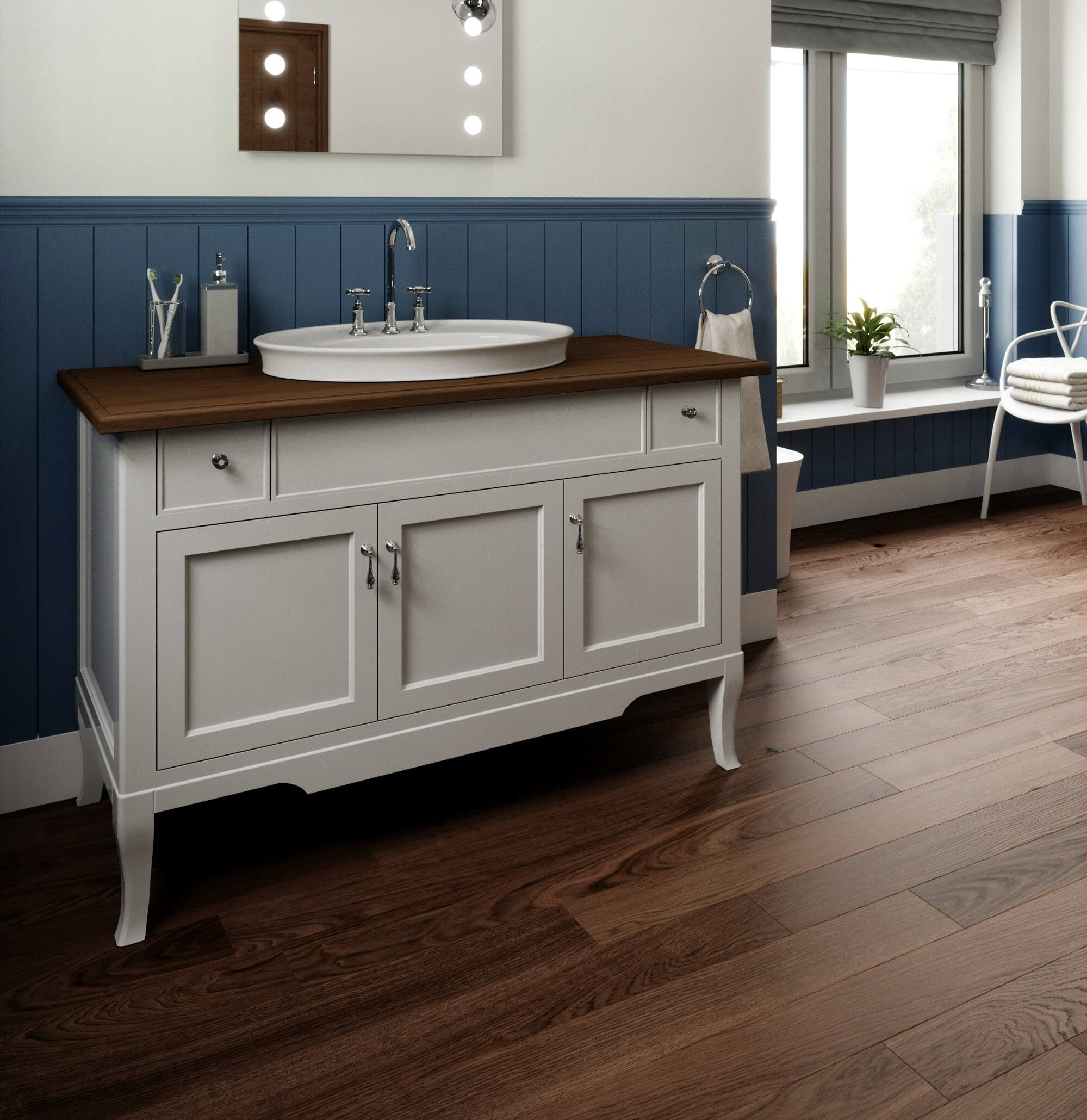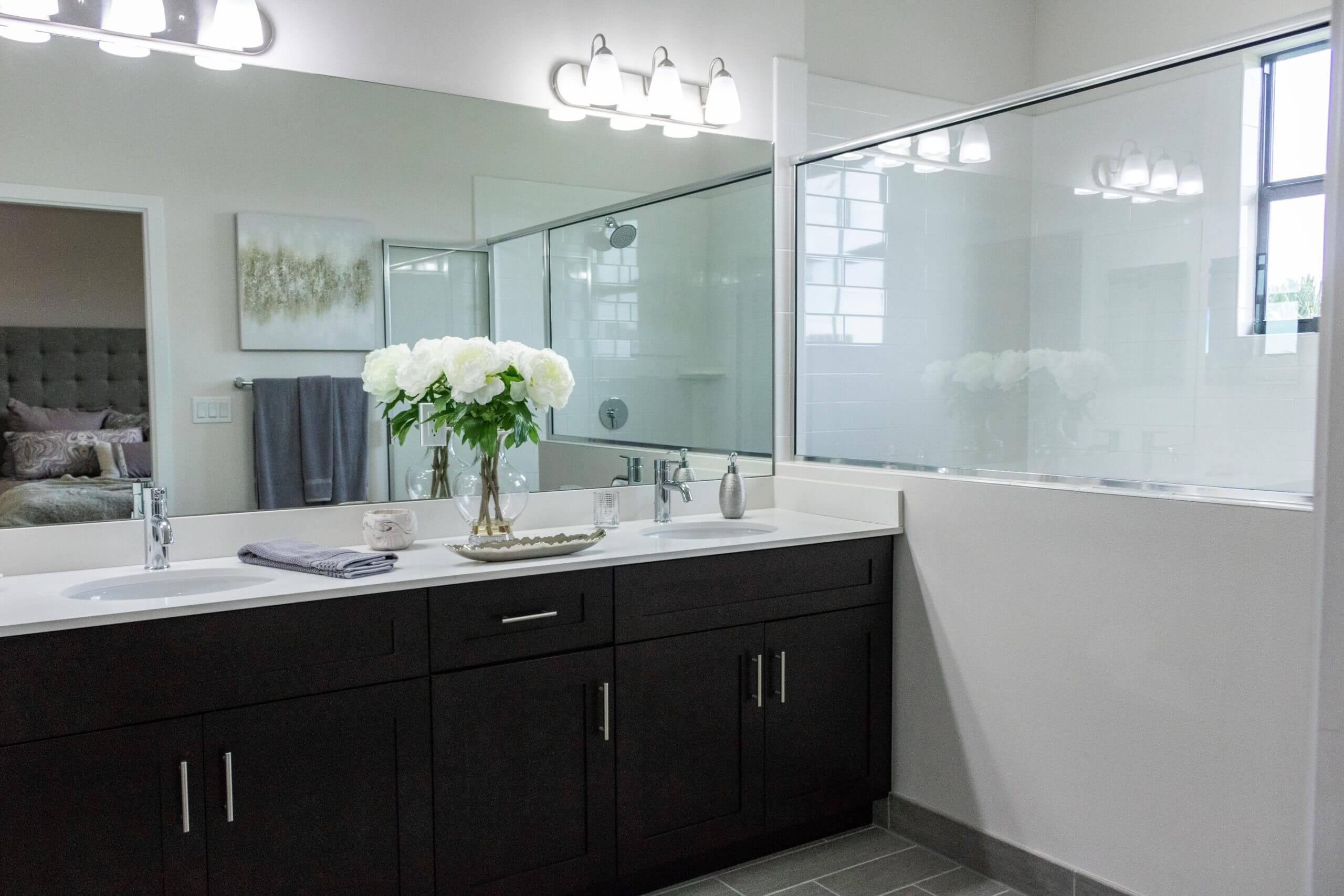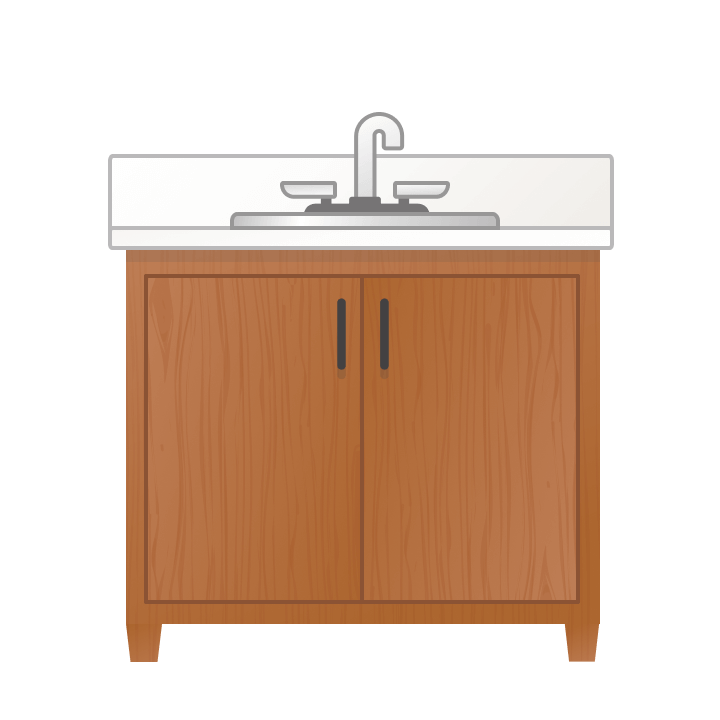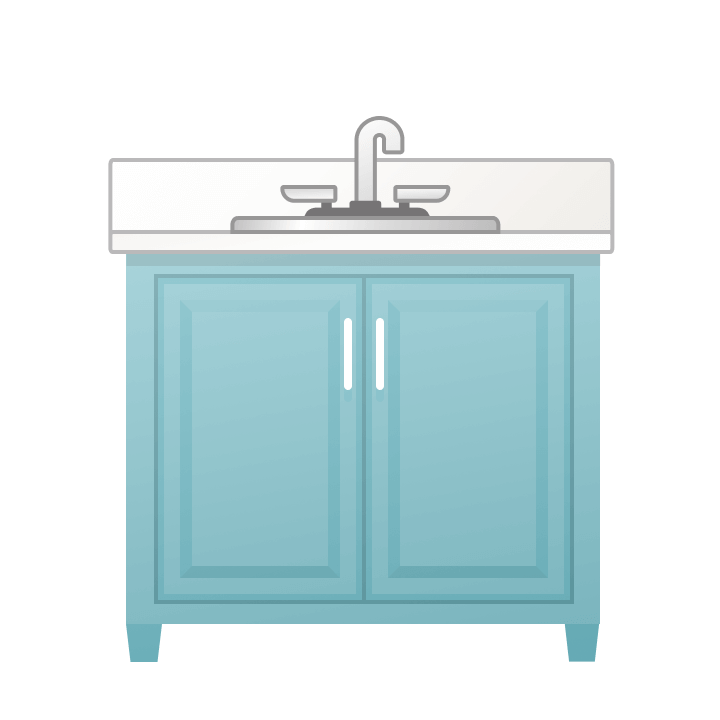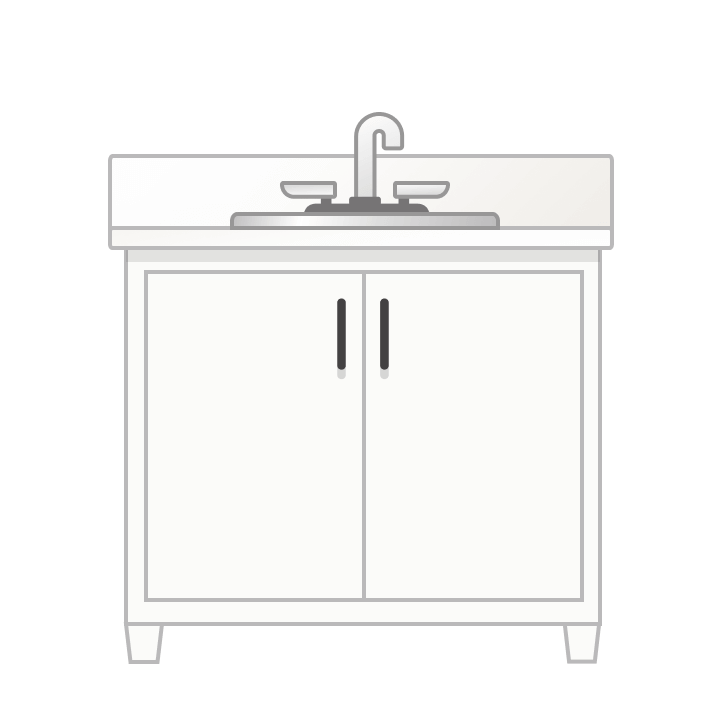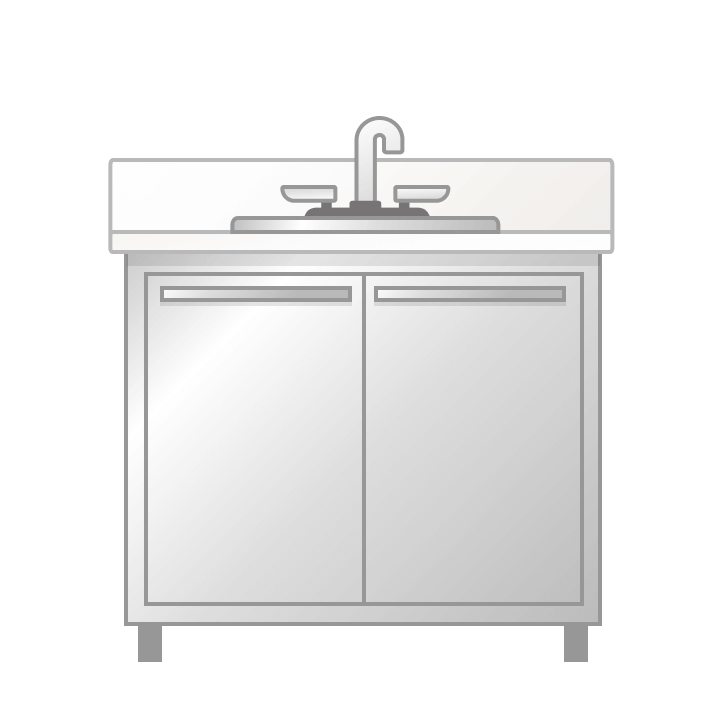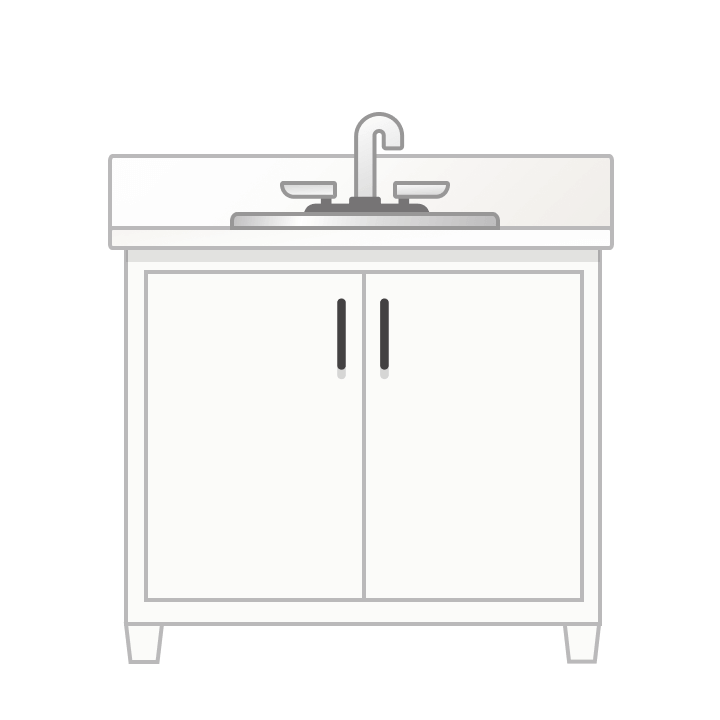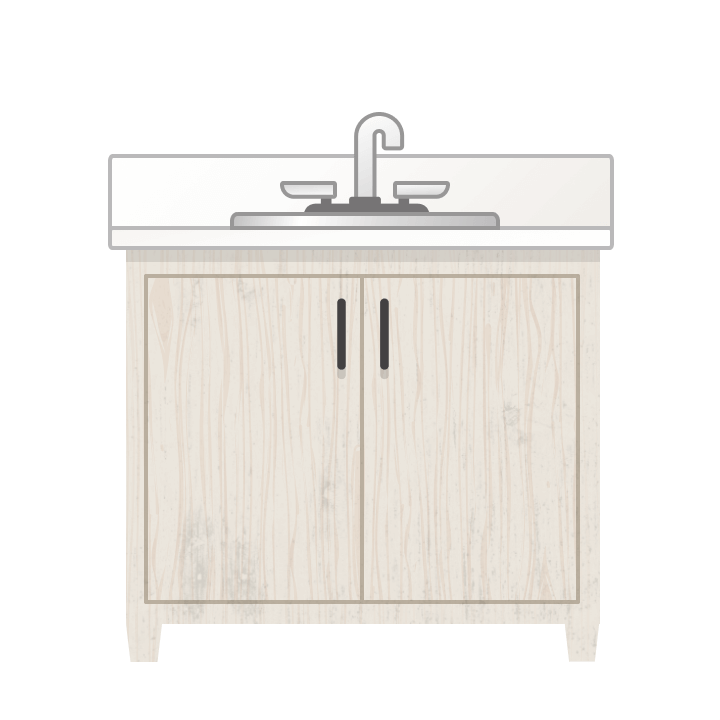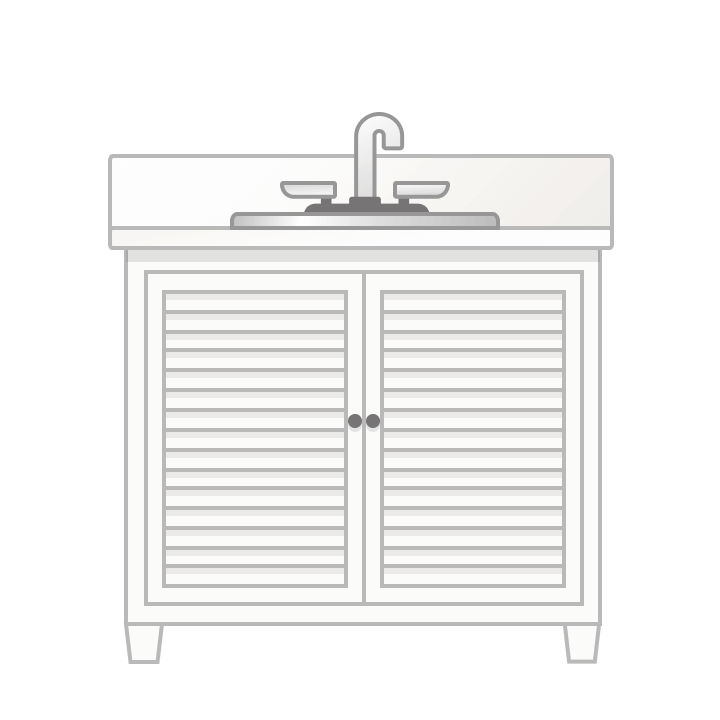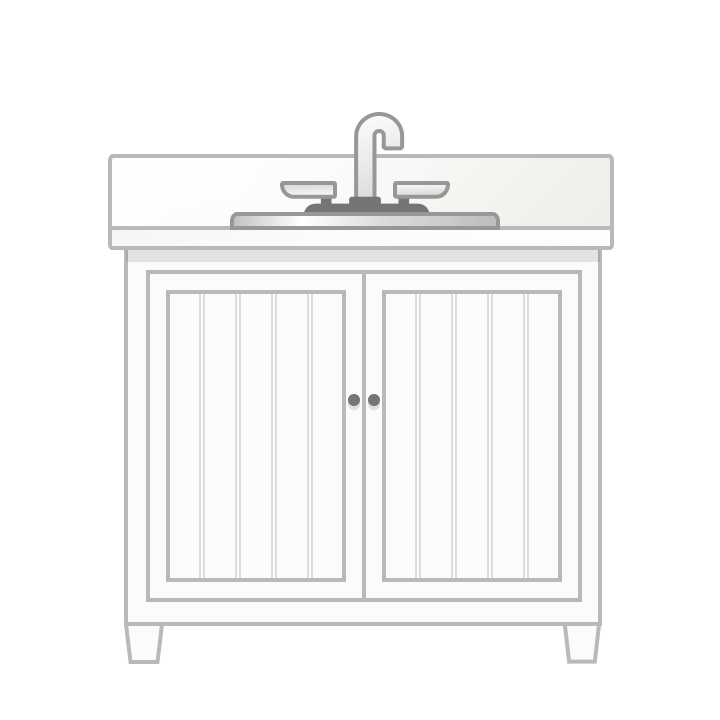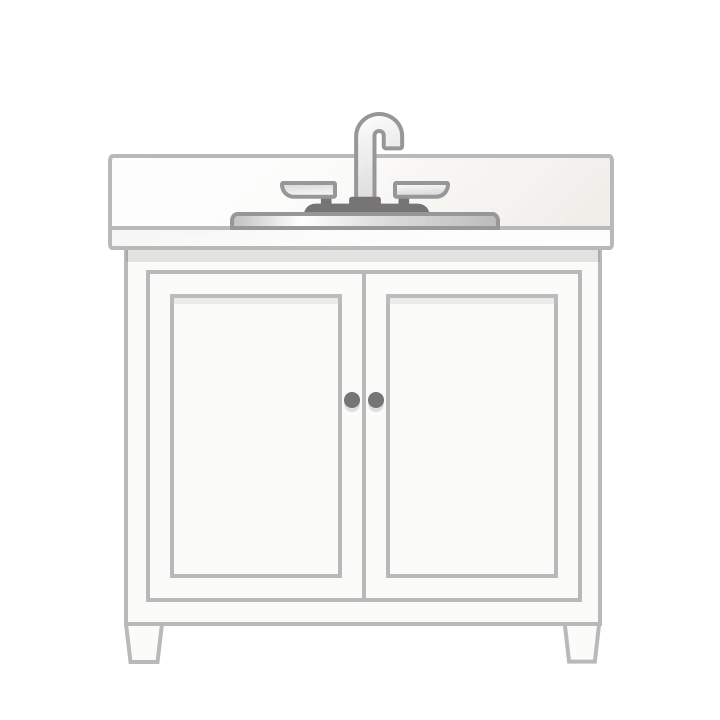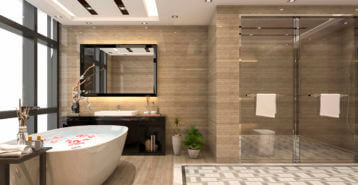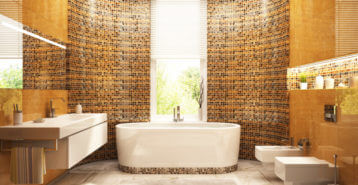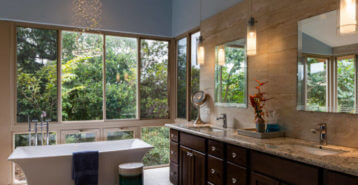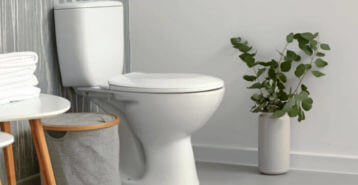A new bathroom vanity or bathroom cabinets can modernize an outdated bathroom, as well as increase bathroom storage and countertop space. Below, you will find ideas for bathroom vanities, a look at the top bathroom vanities, and how to pick a vanity for a small bathroom.
Modernize created this guide to help homeowners choose the right type of vanity and cabinets for their bathroom. We’ll explore costs, vanity heights and sizes, popular materials and styles, and more.
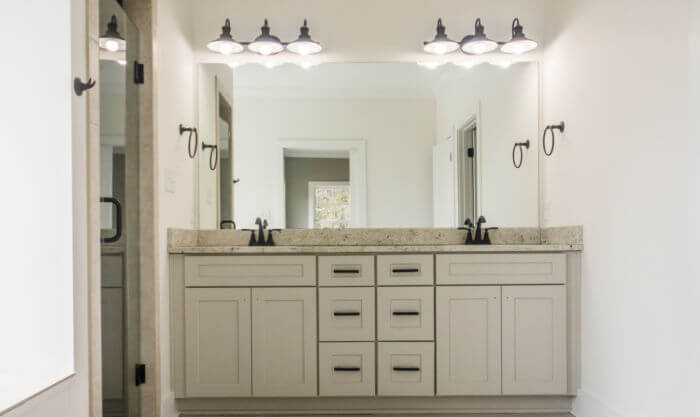
Bathroom Vanities vs. Bathroom Cabinets
To clarify, a bathroom vanity is a standalone piece of furniture while bathroom cabinets have a built-in cabinet boxes with doors. They are drilled directly into the wall. Some homeowners choose to install custom cabinets to increase storage space, especially in bigger spaces.
How to Choose New Bathroom Cabinets and Vanities
There are a few key factors homeowners should consider when searching for a new bathroom vanity and cabinets.
Size
This is the single-most important factor to consider. Vanities come in a wide range of sizes. You want a vanity that is functional and meets your needs without overcrowding the space. We’ll discuss standard bathroom vanity sizes a bit later.
Number of Sinks
Vanities typically have one or two sinks, depending on their overall length. For dual sinks, it is best to have a vanity that measures at least five feet long.
Usage
The type of vanity you choose will be different if you are redesigning a seldom-used guest bathroom vs. transforming your master bath into a luxurious retreat. Key differences include:
- Storage space
- Overall capacity
- Who in the house will primarily be using the bathroom. Kids have different storage and usage requirements than teens, who have different needs than adults.
You should also determine whether you want your bathroom cabinets or vanity to be freestanding units that sit on the floor, or wall-mounted units that float above the bathroom floor.
Average Cost to Install Bathroom Cabinets and Vanities
On average, homeowners can expect to pay around $736 to $2,177 for a basic vanity. That includes demolition of the old vanity, materials, and labor.
However, there are many factors that will affect your bathroom vanity costs. Modernize created this handy bathroom remodel cost calculator to help homeowners establish baseline costs for their remodeling jobs.
Homeowners in the U.S. can expect to pay $1,276 on average for a set of four-door base cabinets.
A freestanding two-door vanity costs an average of $638 for U.S. homeowners.
A custom option that includes four-door cabinets is an average cost of $968 for those in the U.S.
Key factors affecting vanity prices include:
- Size
- Number of sinks
- Choice of materials
- Cabinet style
- Difficulty of removing old vanity and installing new one
- Changes to plumbing or electrical
 Note that some homeowners may choose to repurpose a piece of furniture as a vanity to save money. If you want to go this route, be sure to speak to a bathroom remodeler to ensure the furniture can have a countertop and sinks installed.
Note that some homeowners may choose to repurpose a piece of furniture as a vanity to save money. If you want to go this route, be sure to speak to a bathroom remodeler to ensure the furniture can have a countertop and sinks installed.
Best Bathroom Vanities and Cabinets
Bathroom vanities and cabinets can range from functional to fabulous depending on your remodeling budget. Take a look at the most popular bathroom vanity and cabinet materials below, and some of the pros and cons of each.
Solid Wood Cabinetry
Why Choose Solid Wood Bathroom Cabinets?
Solid wood is one of the most durable and classic choices for bathroom cabinets. You can choose from hardwood or softwood.
Hardwoods:
- Cherry
- Oak
- Maple
- Hickory
Softwoods:
- Pine
- Cedar
One of the benefits of wood cabinets in the bathroom is that they are very versatile. They can be stained, lacquered, and refinished as needed to give your cabinets a visual refresh. However, wood cabinetry is also porous, so it can swell under high humidity conditions. This can lead to warping or cracking issues over time.
What Do Solid Wood Bathroom Cabinets Cost?
Keep in mind that hardwood cabinetry is usually on the high end of the cost spectrum compared to other materials options.
Expect to pay between $1,000 to $1,600 for a designer-grade solid wood bathroom vanity. Costs could be higher for a larger unit with custom door styles, upgraded hardware and double sinks.
Laminate Cabinets
Why Choose Laminate Bathroom Cabinets?
Laminate cabinetry has come a long way from its inception, and is now often used in bathroom remodels for many reasons. One of the biggest reasons for its popularity is that it can be made to mimic natural wood while costing much less to install.
Laminate cabinets use a thin veneer laid atop an engineered-wood core such as MDF or particle board. There are two types: high pressure and low pressure laminate.
High-pressure laminate cabinetry costs more than low-pressure cabinetry, but it is also more durable. The laminate layer can be made from hard pressed plastic, vinyl films, hot-stamped thermofoils, as well as thin sheets of wood.
Laminate cabinetry comes in a tremendous range of styles and finishes to match a wide range of bathroom designs, especially modern or contemporary architecture. It also offers significant cost savings over real wood cabinetry.
However, for laminate cabinets, water saturation can damage the engineered wood core over time. When installing laminate cabinets or vanity, be sure your bathroom is well-ventilated. Delamination also used to be a common problem, but advances in technology and manufacturing processes have largely eliminated this issue in higher-end laminate cabinetry.
What Do Laminate Bathroom Cabinets Cost?
Laminate cabinetry varies greatly in cost. Expect to pay between $450 and $1,200 for a vanity or cabinets. Prices can be higher depending on quality and customization options such as finish and hardware.
Fiberboard (MDF) Cabinets
Why Choose Fiberboard (MDF) Bathroom Cabinets?
Fiberboard, also known as medium density fiberboard, (MDF) cabinets are made from composite wood materials glued together under pressure at high heat. Many homeowners go with MDF cabinets because they are lower cost than hardwood, and do not expand and contract as much as real wood does.
Despite their low price tag, be aware that fiberboard can be difficult to repair if there is a crack or chip. They can also expand from overexposure to moisture and steam.
Fiberboard cabinets can also be made using particle board or plywood, but these shouldn’t be used in the bathroom since they are easily damaged by water. Particle board is especially susceptible to this. Though plywood cabinets offer exceptional durability and are resistant to denting and scratching, plywood also degrades over time when continually exposed to water.
What Do Fiberboard (MDF) Bathroom Cabinets Cost?
An MDF bathroom vanity should cost between $400 and $800. Costs could run higher for larger units with double sinks.
Stainless Steel
Why Choose Stainless Steel Bathroom Cabinets?
Stainless steel rounds out our overview of the materials for top bathroom vanities or cabinets. Stainless steel is becoming more and more popular in bathrooms because of their incredible functionality. They do not absorb water, are resistant to heat and bacteria, and are very easy to clean.
These cabinets and vanities offer incredible durability and functionality for the bathroom. There are two types of commercial steel cabinets: 304 (thicker) and 201 (thinner) grade.
One downside, however, is that stainless steel cabinetry often cannot be made in a wide variety of styles or finishes. The material also can be prone to denting.
What Do Stainless Steel Bathroom Cabinets Cost?
Stainless steel tends to cost more than other types of bathroom vanities. Premium-grade stainless steel cabinetry can cost as much as $2,000 to $3,000 depending on the size.
Ideas for Bathroom Vanities and Cabinets
In addition to material options, bathroom vanities and cabinets come in a variety of styles. Use the guide below to help determine which types of cabinets best match your renovation goals.
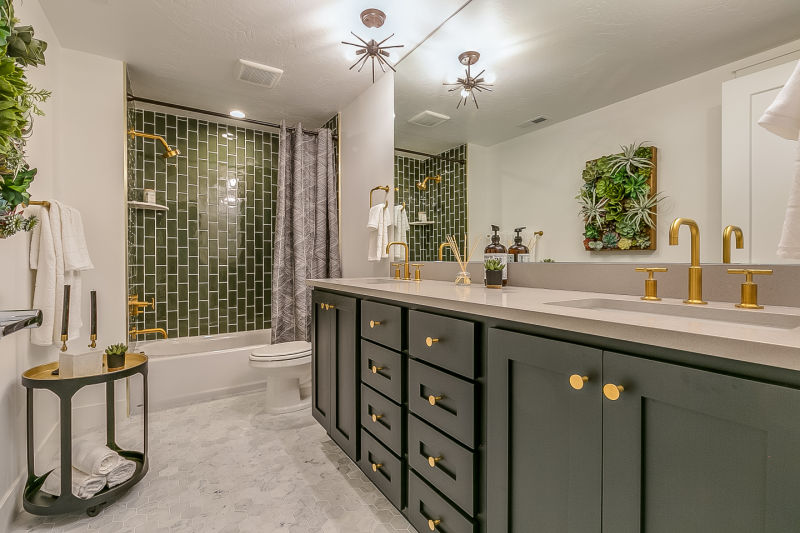
Flat Style
Flat cabinetry has no frames or panels, so it provides a minimalist look that lends itself well to modern architectural styles.
This type of bathroom cabinets and vanities are typically constructed from laminate or solid wood. The face of the cabinets have no features other than hardware pulls. This gives the cabinet or vanity a sleek look that pairs well with and enhances the look of natural stone countertops.
Distressed
Distressed cabinetry has a worn, weathered look that goes well with antique furniture and vintage decor.
Distressing techniques include scraping, gouging, rasping, oversanding and purposeful denting, followed by glazing that highlights these features. Your new cabinets will look like you salvaged them from a century-old home.
You can pair your distressed cabinets with brushed metal or gold accessories, quartz or marble countertops, and farmhouse style décor to pull the room together.
Louvered
Louvered cabinets and vanity doors mimic the look of plantation shutters. Instead of having a solid door panel, the door is made up of a series of louvers.
This style of cabinet provides increased air flow and ventilation throughout the bathroom. Their visual appeal pairs well with any type of décor or architectural style. One potential drawback is that they can take a bit more effort to clean and dust than other cabinet styles.
Beadboard
Beadboard is a traditional style of panel construction that has been used for centuries. This style of cabinet is constructed using evenly spaced planks that lend themselves to country, rustic, farmhouse and cottage-style décor.
Beadboard is typically installed vertically, but the planks also can be installed horizontally to mimic a shiplap look. These cabinets are typically custom-made solid wood or MDF cabinetry.
Inset Style
Inset cabinets are one of the most common types of cabinets for the bathroom. This is partly because they pair well with a tremendous range of architectural styles and interior design schemes.
Full inset cabinets have doors that fit flush with the cabinet frame when the door or drawer is closed. They require more construction detail than other types of cabinetry, so there’s a roughly 15 to 30 percent price premium for full inset doors.
Inset doors also can be:
- Full overlay – The doors and drawers close next to each other, so you cannot see any of the cabinet faces.
- Partial overlay – The most common style of cabinet in residential use – close against the cabinet face with a slight gap between each door.
These cabinets can be made from a range of materials, from solid wood to MDF to laminate.
Standard Bathroom Vanity Sizes
There are so many different styles and materials choices for your new bathroom vanity that narrowing down your options can be difficult. Luckily, choosing the right bathroom vanity size is a bit simpler, since bathroom vanities typically come in standard sizes:
- Vanity height: 32” to 36”
- Common vanity widths: 24,” 30,” 36,” 48,” 62,” and 70”
- Depth: 20” to 21”
How Sinks Change Vanity Height
If you plan on installing a vessel sink, opt for a lower-height vanity since the sinks usually add up to six inches in height. Vanities with dual sinks are typically 60 or 72 inches long. They can be built shorter if necessary.
Small Bathroom Vanity
The size of your bathroom dictates your ideal bathroom vanity dimensions. You want a unit that fits well within the space without overcrowding it.
A vanity with a single sink is probably your best bet for a smaller or half bathroom, but will mean you have less storage space. A bathroom storage cabinet with a sink will give you extra room for organizing, but take up valuable floor space.
To decide what is best for you, do the following:
- Lay out everything that must be stored in the bathroom.
- Put aside anything that can stored somewhere else – like cleaning products – or can be displayed on a floating shelf in a bathroom – like clear jars of q-tips or cotton swabs.
- Look at what you have left. If you need one cabinet and a few pull out drawers, opt for a vanity. The standalone look will make your space feel airier and more open. If you need more than that, opt for a bathroom storage cabinet with a sink. You will lose floor space and the room may seem more crowded, but you will have a deeper and wider cabinet and more drawers, which will keep clutter contained.
- If what you primarily need to store is bulky items like towels and sheets, consider instead installing a bathroom linen cabinet. No room in the bathroom? Linen cabinets can also be installed in hallways, laundry rooms, and other nooks throughout the house.
Adding Sinks and Countertops to Bathroom Vanities
A vanity without a sink and countertop is merely a cabinet. You can opt to install dual sinks in your new vanity, or replace dual sinks with a single sink if you want to downsize. The first option can be costly, since you’ll need to add plumbing and waste lines for a second sink.
To help you make a more confident decision, Modernize provides homeowners with guides to different types of sinks as well as countertop options for bathroom remodels.
Regardless of what option you choose, you should definitely install new sinks while you are upgrading your bathroom vanity. The new countertop and sink will have to be custom-fit and made specific to your new vanity or custom cabinets.
Finding a Bathroom Contractor
Deciding on a bathroom remodel and setting a budget brings you closer to your dream bathroom. The next step is to find a licensed bathroom remodel contractor in your area to assist you in narrowing down all the important decisions you will soon have to make about your new bathroom. Using a professional bathroom contractor can save time and help ensure every aspect of the job gets done correctly and without risk or damage.
Compare top-rated bathroom remodel pros in your area.
Read real homeowner reviews, explore qualifications, and view promotions. Modernize makes it easy to browse professionals and find one that will be perfect for your project.
